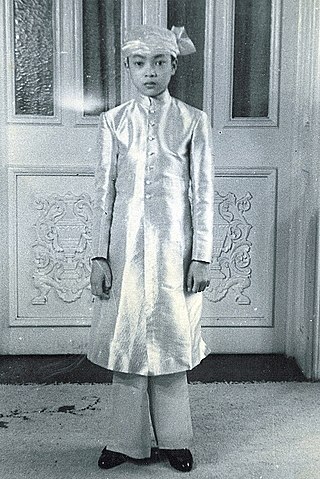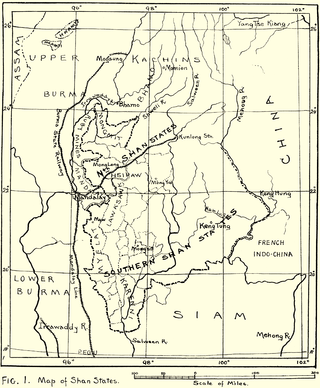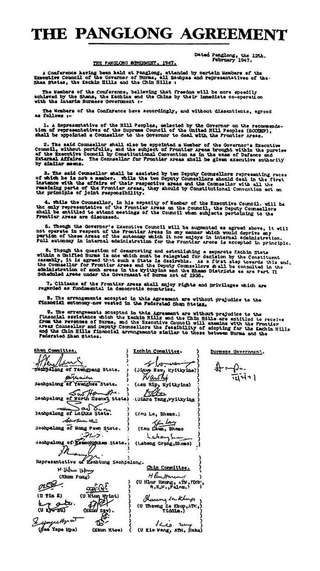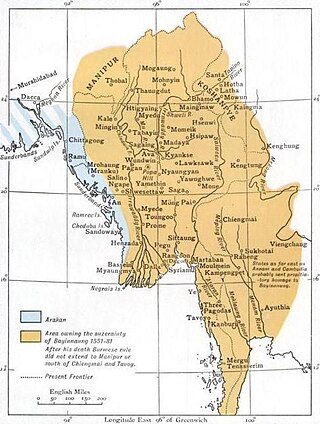
Prince Hso Khan Pha of Yawnghwe was a prince of Yawnghwe. He was a son of Sao Shwe Thaik, the Saopha of Yawnghwe and Sao Nang Hearn Kham, the Mahadevi (consort). He was a consulting geologist based in Canada.

Wuntho or Waing Hso was a native state of Upper Burma when Burma (Myanmar), was under British control. It had an area of around 6,200 square kilometres (2,400 sq mi) with 150,000 inhabitants and lay midway between the Ayeyarwady River and Chindwin Rivers.

Myelat is a historical region of the southwestern Shan State of Myanmar. Originally this region included some of the smaller states typically ruled by "Myosas" or "Ngwegunhmus", buffering the plains of Burma and the ethnic Shan states further east.

Yawnghwe, known as Nyaungshwe in Burmese, was a Shan state in what is today Myanmar. It was one of the most important of the Southern Shan States. Yawnghwe state included the Inle Lake. The administrative capital was Taunggyi, located in the northern part of the state. The Agent of the British government, the Superintendent of the Southern Shan States, resided at Taunggyi and the king's palace was at Yawnghwe.

The Panglong Agreement was reached in Panglong, Southern Shan State, between the Burmese government under Aung San and the Shan, Kachin, and Chin peoples on 12 February 1947. The agreement accepted "full autonomy in internal administration for the Frontier Areas" in principle and envisioned the creation of a Kachin State by the Constituent Assembly. It continued the financial relations established between the Shan states and the Burmese federal government, and envisioned similar arrangements for the Kachin Hills and the Chin Hills. The anniversary of this agreement is celebrated annually as Union Day.
Burmese names lack the serial structure of most Western names. The people of Myanmar have no customary matronymic or patronymic naming system and therefore have no surnames. In the culture of Myanmar, people can change their name at will, often with no government oversight, to reflect a change in the course of their lives. Also, many Myanmar names use an honorific, given at some point in life, as an integral part of the name.
Tagaung is a town in Mandalay Region of Myanmar (Burma). It is situated on the east bank of the Ayeyarwady River, 127 miles north of Mandalay.

Kenglon, also known as Kyainglun was a small Shan state in what is today Burma.

Kyawkku was a Shan state in the Myelat region of what is today Burma. Its capital was the village of Kyawkku (Myinkyado) which had 344 inhabitants in 1901.

Loi-ai was a Shan state in the Myelat region of what is today Burma. It was one of the westernmost Shan states, bordering with Yamethin district of Upper Burma. The capital was Lonpo (Aungpan) and the population was mostly Pa-O, but there were also Danu, Shan and Karen people in the area.

Maw, was a Shan state in what is today Burma. It was the northernmost and the second largest of the states of the Myelat region at the western end of the Shan States.
Mawnang was a small Shan state in the Myelat region of what is today Burma. Its population was mostly Taungyo.

Singaling Hkamti was a Shan state in what is today Burma. It was an outlying territory, away from the main Shan State area. The state was located on both sides of the Chindwin River, in what is present-day Hkamti District, Sagaing Region. Its capital was Singaling Hkamti town.

Mongmit or Möngmit, also known as Momeik, was a Shan state in the Northern Shan States in what is today Burma. The capital was Mongmit town. The state included the townships of Mongmit and Kodaung.

Mongnai, also known as Möngnai, Mone, Mōng Nai or Monē, was a Shan state in what is today Burma. It belonged to the Eastern Division of the Southern Shan States. Its capital was Mongnai town.

Mongpan, also known as Maingpan was a Shan state in what is today Burma. It belonged to the Eastern Division of the Southern Shan States.

Mongpai, also known as Mobye, was a Shan state in what is today Burma. It belonged to the Central Division of the Southern Shan States. Mongpai was based in the modern town of Mobye.
Yengan was a Shan state in what is today Burma. It belonged to the Myelat Division of the Southern Shan States.

Kengtung, known as Menggen Prefecture or Möng Khün Chiefdom or Mueng Khuen Fu from 1405 to 1895, was a Shan state in what is today Burma. The capital and the residence of the ruler was Kengtung in the centre of the state. It was the only urban area in this mountainous state whose landscape is dominated by the Daen Lao Range.

Mogaung or Möngkawng was a Shan state in what is present-day Myanmar. It was an outlying territory, located away from the main Shan State area in present-day Kachin State. The state existed until 1796. The main town was Mogaung.








